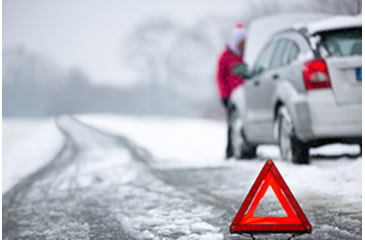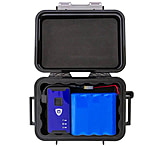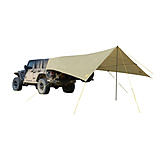It happens practically every year: the weather starts to turn cold, and the forecast calls for snowfall. Doesn't it also feel that everyone seemingly forgets how to drive in the snow? When that first snowstorm happens, everyone seemingly needs to learn how to drive in winter weather again. We have compiled several driving tips to help you better prepare for winter travel in bad weather. Even if you live in an area that gets snow every year or from a place where snow is a rarity, it is vital to know these winter driving safety tips to keep yourself, your family, and other drivers safe when cold weather road conditions are not the best.![]()
What Do You Take if Traveling in Winter Weather?
You can also make an emergency kit for your car if you get stranded or stuck in the snow and have to wait for emergency rescuers. Here is a list of items you should have in your vehicle in bad weather.
- Jumper Cables
- Flares or Reflectors
- Windshield Wiper Fluid & Antifreeze
- Ice Scraper
- Traction Material such as kitty litter
- Blankets & Sleeping Bags
- Non-Perishable Food
- First-Aid Kit
- Cell Phones, Chargers, & Power Banks
- Bring extra winter clothes, such as winter gloves, hats, and socks, for everyone who is going to be in the vehicle.
- Garmin inReach Mini GPS, If you are traveling in/through areas with no cell service.
What Are Some Safety Tips for Driving in Winter Weather?
- Wear a seatbelt.
- Drive slow and steady. Drive at slower speeds when road conditions are bad. Accelerate slowly when the light turns green or at a stop sign. Break slowly when coming to a stop. Be sure also to increase the distance between your vehicle and the vehicles around you, especially those ahead of you.
- Keep your gas tank close to full whenever possible for several reasons. If your car is stranded, having a full tank can keep you warm while waiting for help. Another reason to keep your gas tank as full as possible in the winter is that air fills the gas tank that is not filled by gasoline. Condensation occurs when colder water vapor comes into contact with a warmer surface. Water droplets can form on the inside of the gas tank. This is bad news as gas and water do not mix. The water sinks to the bottom of the gas tank. This can cause corrosion in the tank and through the rest of the engine.
If the temperature drops even colder, any water in the fuel lines can freeze, preventing gasoline from getting into the engine and potentially stalling the engine or even refusing to start. - Be aware of black ice conditions; intersections, ramps, bridges, and shady areas are especially prone to black ice. Do not use cruise control when driving on icy roads, either.
- Make a plan if you need to drive in wintry conditions. If the forecast calls for winter storms, stay home and wait until conditions improve. Give yourself enough time to leave, and don't rush to your destination.
- Make sure to have an emergency kit in your vehicle if your car gets stuck in the snow or has an accident. Remember that an emergency kit doesn’t stop at first aid; don’t forget a blanket. Here are some more tips on what to include in Emergency Kits.
It can be safe; however, a few precautions must be taken before a winter road trip.
- Be aware of weather advisories and road closures.
- Get a car checkup before your trip.
- Pack your emergency kit before any winter travel!
- When driving conditions are not the best, tire tread is important to keep in good shape if you need to navigate through ice and snow. A minimum of 5/32" of tread is necessary to provide good traction.
- Be sure to check your tire inflation. Tire pressure decreases by one pound for every 10-degree drop in temperature. Radial "all-weather" tires are recommended. Studded snow tires provide better traction on snow, while chains are best for stopping and starting in severe snow and ice conditions.
While winter driving can seem nerve-wracking at times, the most important information is to drive slowly when road conditions are bad. Preparedness is your best friend when weather conditions go from bad to worse. Make an emergency car kit and get your car taken into the shop to make sure there are no issues, or get any problems taken care of early. If you follow these driving safety tips, you’ll have a great winter season!









